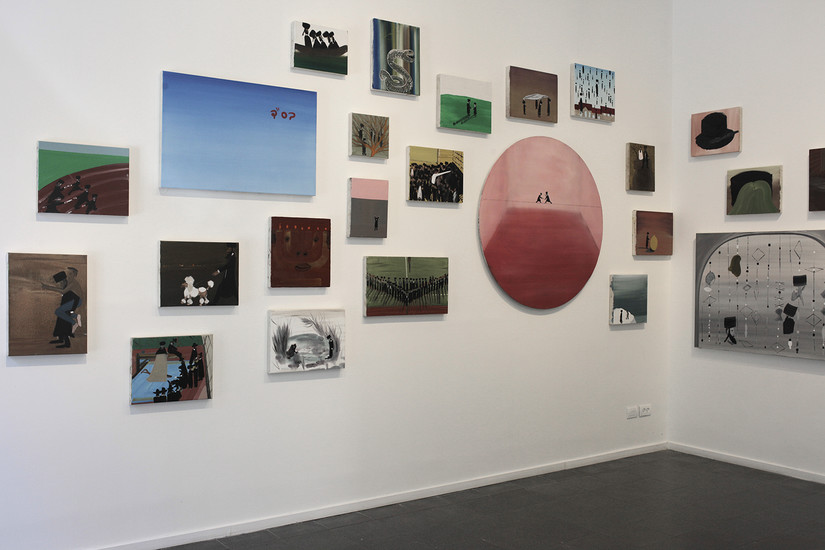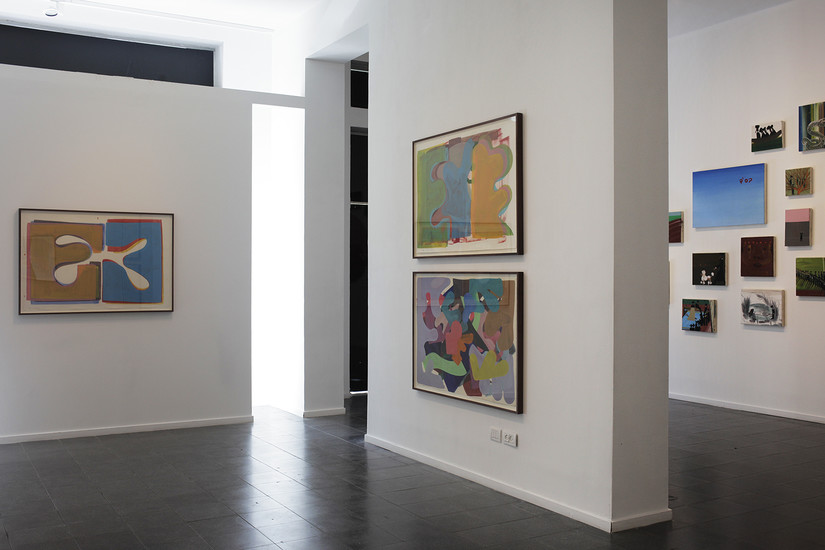Dos
Shai Azoulay
“Dos” / “Spiritual Abstract”, Shai Azoulay
“There are three types of Hassidim: the one that wants scraps, the second wants to hear Torah, and the third – whose Rabbi burns in his heart”. (Rabbi Nachman of Breslov, Chayey Moharan)
The artist Shai Azoulay commits another component in his spiritual work, and worships his god by the “act” of painting- And an action it is indeed.
“An artist must make a rock speak”, so he says.
Azoulay commits his singular prayer in his private studio, without a prayer group or any audience, he holds the paint-laden brush and thrusts it at the stretched canvas. He stains it, leading, collecting and folding his outlines within it, as a cantor holding the silver pointer and wandering with it upon the Torah scroll, pointing in revelation and uncovering black ink letters upon the leather surface.
[collapsed]
Azoulay is a representative of the public who aims to document, immortalize and create meeting points of seemingly everyday events amongst the Hasidic community, which lives and functions in a hermetically sealed environment of their own, strangers and strange to the world outside them. In his mission as a “painting laborer” he traces a thin line upon a delicate wall. He is not an anthropologist documenting religious, mystical, and transcendent moments – instead he works through them, simultaneously from the perspective of a believer, a newly orthodox Jew, and from that of a rich painterly tradition of precise, indefatigable work.
"The whole of the world is a very narrow bridge”, writes Rabbi Nachman of Breslov. Azoulay is precisely that bridge: in his world order, his actions and his manners there is no separation between the everyday activities of working in the studio, praying communally, attending critique sessions at universities of contemporary art, retreating to a field, laying Tefilin, and presenting artwork at local art spaces.
The bridge, or fence, as it were, is formed and lives between these two worlds, and is borne and created as though from thin air.
In Azoulay’s paintings, a simple and colorful documentarization becomes humorist, playful and teasing. The Gemora’s chapter on “Tractate Sotah” poses the question of who is a “Hassid fool”, providing plenty of examples and explanations.
Azoulay does not point a blaming finger, he is devoid of criticism. His Hassidim are often painted as blots, their faces erased and expressionless, with their Shtreimel, capes, coats and white stockings, “unexposed”, the private Hassid as an indefinable identity. A black mark flowing in a colorful field bursting with life.
His Hassidim carry with them a past, often a heavy burden of religion, order and hierarchy as they sit to the great Rabbi’s Tisch, in his court, as he delivers his shattering weekly sermon. At this obligatory call to arms they bow under the wings of the Holy Presence, awed by the gaping skies that slowly send out gracious threads of light.
And here, in the piece “Poodle”, a stereotypical Jewish Hassid walks in a deserted field, dark and muddy, as dim city lights glow behind him, as though reminding the wanderer of his past as a reference scale, a starting point marking the beginning, middle, and unknown destination. The Hassid is no symbol for the Messiah, he does not ride a white donkey. He is split, cross-bred, multicultural, possibly dragging or being dragged by a live witness in his past, with a poodle accompanying him on his spiritual journey.
If the Hassidim in the series “Dos” are devoid of expressions, of facial features, then in the image “The Seven Openings” the Menorah’s seven stalks are fitted or planted with human-like “eyes”, “ears”, “nostrils” and “mouths”. The formal articulation and presentation of the Menorah aims to ascribe it with a unique sketch of the “facial openings” – a painting intended at morality, as Halakhic instructions for lighting the inner Menorah.
The Jewish Kabbalah and mysticism are based on the “laws of form equation” – images are attracted to images, events to people, and people are drawn to the realms of the world in which they are manifest. Azoulay opens up yet another “channel” that looks upon the breakage of form, doubling of image, veiling, revealing and unmasking.
He will present the second series as a bolster, an addition or the key to a code. Azoulay names it the “Spiritual Abstract”. What is the tie between abstract and spiritual? Everything. The world comes to an end for lack of a common and clear language. The limit of language is the limit of man. And that is where rules and tools will be broken, and the opening to the heavens will take place. Eleven “Abstract spiritual” paintings (oil on paper) comprise the window to Henri Matisse’s legacy, and an option of mysterious ethics, of a subconscious. Azoulay appropriates graphic citations, signal and samples of sign language that deal with the secret of mark and form.
Israel Kabala
[/collapse]






